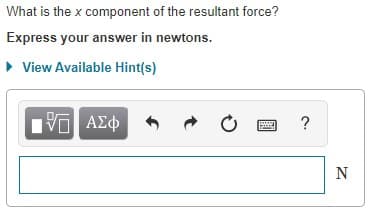What is the x component of the resultant force? Express your answer in newtons. • View Available Hint(s) Two forces, F1 and F2, act at a point. Fi has a magnitude of 8.00 N and is directed at an angle of 63.0 ° above the negative x axis in the second quadrant. F2 has a magnitude of 6.00 N and is directed at an angle of 53.3° below the negative x axis in the third quadrant.
What is the x component of the resultant force? Express your answer in newtons. • View Available Hint(s) Two forces, F1 and F2, act at a point. Fi has a magnitude of 8.00 N and is directed at an angle of 63.0 ° above the negative x axis in the second quadrant. F2 has a magnitude of 6.00 N and is directed at an angle of 53.3° below the negative x axis in the third quadrant.
Physics for Scientists and Engineers
10th Edition
ISBN:9781337553278
Author:Raymond A. Serway, John W. Jewett
Publisher:Raymond A. Serway, John W. Jewett
Chapter3: Vectors
Section: Chapter Questions
Problem 7P: A force F1 of magnitude 6.00 units acts on an object at the origin in a direction = 30.0 above the...
Related questions
Question
Two forces, F⃗ 1F→1F_1_vec and F⃗ 2F→2F_2_vec act at a point. F⃗ 1F→1F_1_vec has a magnitude of 8.00 NN and is directed at an angle of 63.0 ∘∘ above the negative x-axis in the second quadrant. F⃗ 2F→2F_2_vec has a magnitude of 6.00 NN and is directed at an angle of 53.3 ∘∘ below the negative x-axis in the third quadrant.

Transcribed Image Text:What is the x component of the resultant force?
Express your answer in newtons.
• View Available Hint(s)

Transcribed Image Text:Two forces, F1 and F2, act at a point. Fi has a magnitude
of 8.00 N and is directed at an angle of 63.0 ° above the
negative x axis in the second quadrant. F2 has a magnitude
of 6.00 N and is directed at an angle of 53.3° below the
negative x axis in the third quadrant.
Expert Solution
This question has been solved!
Explore an expertly crafted, step-by-step solution for a thorough understanding of key concepts.
This is a popular solution!
Trending now
This is a popular solution!
Step by step
Solved in 2 steps with 3 images

Knowledge Booster
Learn more about
Need a deep-dive on the concept behind this application? Look no further. Learn more about this topic, physics and related others by exploring similar questions and additional content below.Recommended textbooks for you

Physics for Scientists and Engineers
Physics
ISBN:
9781337553278
Author:
Raymond A. Serway, John W. Jewett
Publisher:
Cengage Learning

Physics for Scientists and Engineers with Modern …
Physics
ISBN:
9781337553292
Author:
Raymond A. Serway, John W. Jewett
Publisher:
Cengage Learning

University Physics Volume 1
Physics
ISBN:
9781938168277
Author:
William Moebs, Samuel J. Ling, Jeff Sanny
Publisher:
OpenStax - Rice University

Physics for Scientists and Engineers
Physics
ISBN:
9781337553278
Author:
Raymond A. Serway, John W. Jewett
Publisher:
Cengage Learning

Physics for Scientists and Engineers with Modern …
Physics
ISBN:
9781337553292
Author:
Raymond A. Serway, John W. Jewett
Publisher:
Cengage Learning

University Physics Volume 1
Physics
ISBN:
9781938168277
Author:
William Moebs, Samuel J. Ling, Jeff Sanny
Publisher:
OpenStax - Rice University

Principles of Physics: A Calculus-Based Text
Physics
ISBN:
9781133104261
Author:
Raymond A. Serway, John W. Jewett
Publisher:
Cengage Learning

Glencoe Physics: Principles and Problems, Student…
Physics
ISBN:
9780078807213
Author:
Paul W. Zitzewitz
Publisher:
Glencoe/McGraw-Hill